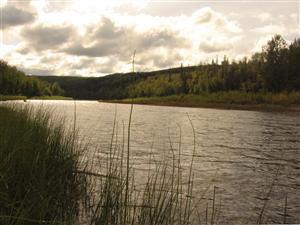Water Management
Federal and provincial policies and initiatives have been created to address the management of water resources. Alberta’s recent Water for Life strategy focuses on stakeholder perception of water use in the province. At the federal level, the Federal Water Policy is in place to protect aquatic environments and water quality in Canada. Other policy initiatives, including the Muskeg River Interim Water Management Framework and the Clearwater-Christina Rivers Management Plan, as well as the Northern Rivers Ecosystem Initiative, provide further direction and information on managing water resources in the oil sands region.
Water for Life
Water for Life is a provincial strategy created by the government of Alberta for the wise and sustainable management of Alberta’s water resources. A strategy was needed because a growing population, drought, and agricultural and industrial development are all increasing pressure on Alberta’s water resources.
The strategy was developed through a public consultation process to establish stakeholder needs and opinions. The strategy addresses three issues on which Albertans expressed the most concern: safe, secure drinking water supply, healthy aquatic ecosystems, and reliable, quality water supplies for a sustainable economy.
The following principles provide the foundation for the Water for Life strategy (Alberta Environment 2003):
- All Albertans must recognize there are limits to the available water supply
- Alberta’s water resources must be managed within the capacity of individual watersheds
- Citizens communities, industry and government must share responsibility for water management in Alberta, and work together to improve conditions within their local watershed
- Knowledge of Alberta’s water supply and quality is the foundation for effective decision-making
- Albertans must become leaders at using water more effectively and efficiently, and will use and re-use water wisely and responsibly
- Alberta will preserve the “First-in-time, first-in-right” principle for granting and administering water allocations, but water allocations will be transferable within basins to ensure societal demands and needs can be met
- Where water supply is limited, water allocations can be transferred to provide security of supply, and accommodated new users
- Healthy aquatic ecosystems are vital to a high quality of life for Albertans and must be protected
- Groundwater and surface water quality must be protected in pursuing economic and community development
- Alberta will continue to be a leader in drinking water quality and standards to ensure Albertans have safe, secure drinking water.
To address concerns about water flow in the Athabasca River, the Athabasca River Water Management Framework has been developed to limit water withdrawal from the Athabasca River during environmentally sensitive periods (Alberta Environment, 2007a).
Federal Water Policy
The Federal Water Policy was created in 1987 and has not been updated since. Though many of its guidelines and initiatives remain valid, it should be used mainly as an information resource and not as a guide to current practice (Environment Canada 2007a).
Muskeg River Interim Management Framework for Water Quantity and Quality
The Muskeg River IMF was developed by Alberta Environment in 2008 in response to the potential disturbance of over 50% of the watershed by the oil sands industry. The IMF defines limits and targets for water quality and quantity, and is used to help manage development and guide regulatory decision-making. A comprehensive water management plan for the Muskeg watershed is targeted for completion by the end of 2009.
Clearwater-Christina Rivers Management Plan (CCRMP)
The CCRMP applies to the entire Alberta section of the Clearwater River and the lower 31 km of the Christina River. The management plan was developed in response to the designation of the Clearwater River as a Canadian Heritage River in 1994. The management plan is neither legislative nor regulatory, but provides guidance related to several themes (e.g., natural integrity, human heritage, commercial/industrial use) for decision-makers.
Northern Rivers Ecosystem Initiative
Completed in 2003, the Northern Rivers Ecosystem Initiative (NREI) was created to implement recommendations arising from the Northern Rivers Basin Study (1992–1996). The Northern Rivers Ecosystem Initiative was a joint initiative between the governments of Canada, Alberta and the Northwest Territories, and was undertaken to determine the effects of development on northern river ecosystems. The study covered pollution prevention, water quality, wildlife and biodiversity, water basin management, hydrology, and climate, among others topics (Environment Canada 2005).










